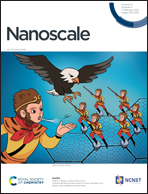Palladium-modified cuprous(i) oxide with {100} facets for photocatalytic CO2 reduction†
Abstract
Using metal as a photohole capturer can promote the photoelectron of p-type copper(I) oxide (Cu2O) substrate for efficient carbon dioxide reduction. However, palladium-decorated Cu2O (Cu2O–Pd) is seldom reported due to their mismatching band arrangement. Herein, we have successfully established a matched band alignment between Pd nanoparticles and Cu2O with exposed {100} facets (100Cu2O). The high work function of 100Cu2O originating from T1u symmetry vibration facilitates the photohole transferring to Pd nanoparticles, which leads to a three-fold increase in the photocatalytic generation of carbon monoxide (100Cu2O–0.1Pd, 0.13 μmol g−1 h−1) than that with pristine 100Cu2O (0.04 μmol g−1 h−1). Besides, the incorporation of Pd can relieve the photocorrosion of 100Cu2O, thus promoting its photocatalytic stability. As a contrast, 111Cu2O (Cu2O exposed to {111} facets) with low-work function was also synthesized and no charge migration was observed between 111Cu2O and Pd species, which verified the important role of the crystal surface regulation. All experimental phenomena were certified by the crystal surface analysis and energy band structure construction. Moreover, CO2 adsorption capacity tests indicated that the incorporation of Pd is beneficial for the capture of CO2 molecules. We hope that this work to some extent will enrich the subject of photocatalytic CO2 reduction.

- This article is part of the themed collection: 2021 Nanoscale HOT Article Collection


 Please wait while we load your content...
Please wait while we load your content...